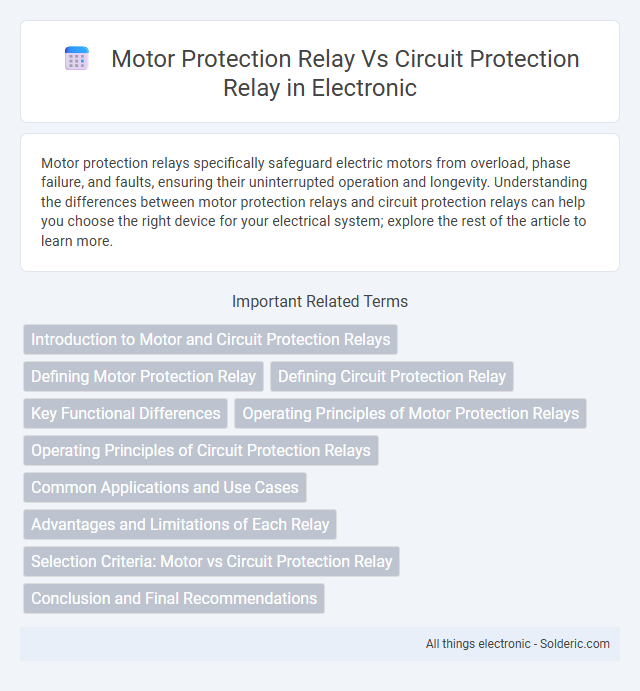Motor protection relays specifically safeguard electric motors from overload, phase failure, and faults, ensuring their uninterrupted operation and longevity. Understanding the differences between motor protection relays and circuit protection relays can help you choose the right device for your electrical system; explore the rest of the article to learn more.
Comparison Table
| Feature | Motor Protection Relay | Circuit Protection Relay |
|---|---|---|
| Purpose | Protects motors from faults like overload, phase failure, and overheating | Protects electrical circuits from overload, short circuit, and fault conditions |
| Application | Used specifically in motor control panels and motor-driven systems | Used across electrical distribution systems and general circuits |
| Protection Types | Overload, phase loss, phase unbalance, stall, temperature | Overcurrent, short circuit, earth fault, thermal overload |
| Detection Mechanism | Monitors motor-specific parameters like current imbalance and temperature | Monitors current flow and electrical faults in circuits |
| Coordination | Designed to coordinate with motor starters and drives | Coordinates with circuit breakers and fuses |
| Examples | Siemens 3UG Motor Protection Relay, ABB RET670 | Schneider Electric Micrologic, Eaton Overcurrent Relay |
Introduction to Motor and Circuit Protection Relays
Motor protection relays are specialized devices designed to safeguard electric motors by detecting faults such as overloads, phase failures, and short circuits, ensuring reliable motor operation and preventing damage. Circuit protection relays provide broader protection for electrical circuits by monitoring for abnormal conditions like overcurrent, ground faults, and voltage irregularities to maintain overall system safety. Both relay types play critical roles in industrial automation and power distribution systems by enhancing equipment longevity and minimizing downtime.
Defining Motor Protection Relay
Motor Protection Relay monitors electrical parameters such as current, voltage, and temperature to safeguard motors from faults like overload, phase failure, and short circuits. It specifically detects abnormal conditions in motors, ensuring prompt disconnection to prevent mechanical damage and prolong motor lifespan. This relay is essential in industrial applications where motor reliability and efficiency are critical.
Defining Circuit Protection Relay
Circuit protection relay is a specialized device designed to detect faults and abnormal conditions in electrical circuits, such as overloads, short circuits, and ground faults, ensuring the safety and reliability of electrical systems. Unlike motor protection relays that primarily safeguard motors by monitoring parameters like current, voltage, and temperature, circuit protection relays provide comprehensive protection for a wide range of electrical equipment and distribution networks. Their role is crucial in preventing damage to infrastructure, minimizing downtime, and enhancing overall electrical system stability.
Key Functional Differences
Motor protection relays primarily monitor electrical parameters such as current, voltage, phase imbalance, and temperature to protect motors from faults like overloads, phase failures, or stall conditions. Circuit protection relays focus on detecting and isolating faults in electrical circuits including short circuits, overloads, and ground faults to prevent damage and maintain system stability. While motor protection relays are specialized for motor-specific fault detection and trip functions, circuit protection relays serve broader roles in overall electrical network protection and fault isolation.
Operating Principles of Motor Protection Relays
Motor Protection Relays operate by continuously monitoring electrical parameters such as current, voltage, and temperature to protect motors from faults like overloads, phase failures, and short circuits. These relays use thermal, magnetic, or electronic sensing techniques to detect abnormal conditions and interrupt the motor circuit before damage occurs. Your motor's safety depends on the precise and timely response of these relays to prevent winding insulation failure and mechanical wear.
Operating Principles of Circuit Protection Relays
Circuit protection relays operate by continuously monitoring electrical parameters like current, voltage, and frequency to detect abnormalities such as overloads, short circuits, and ground faults. They utilize sensors and algorithms to compare real-time data against preset thresholds, instantly triggering circuit breakers to isolate faulty sections and prevent equipment damage. Understanding these operating principles helps ensure your electrical system is safeguarded effectively against faults.
Common Applications and Use Cases
Motor Protection Relays are designed primarily to safeguard electric motors from faults such as overloads, phase failure, and short circuits, making them essential in industrial machinery and HVAC systems. Circuit Protection Relays provide broader protection across electrical circuits, detecting faults like overcurrent and ground faults in distribution panels and power grids. Your choice depends on whether the focus is on protecting motors specifically or protecting entire electrical circuits in residential, commercial, or industrial settings.
Advantages and Limitations of Each Relay
Motor protection relays offer precise monitoring of motor parameters such as overload, phase failure, and temperature, ensuring enhanced motor safety and longevity, but they can be complex and costly to install. Circuit protection relays provide broad protection for electrical circuits against faults like short circuits and overloads, offering quick response times and simpler integration, yet they may lack the detailed diagnostic capabilities found in motor protection relays. Choosing the right relay depends on your specific application needs, balancing between comprehensive motor protection and general circuit defense.
Selection Criteria: Motor vs Circuit Protection Relay
Motor Protection Relays are designed specifically to safeguard motors against faults such as overloads, phase failures, and stall conditions by continuously monitoring current, voltage, and temperature parameters. Circuit Protection Relays provide broader protection by detecting faults in electrical circuits like short circuits, overloads, and ground faults to ensure overall system safety. When selecting a relay, you should consider the unique operational characteristics and fault conditions of motors for Motor Protection Relays, whereas Circuit Protection Relays require assessment of the entire electrical system's load and fault profiles.
Conclusion and Final Recommendations
Motor protection relays specialize in safeguarding motors from faults such as overloads, phase failures, and ground faults, ensuring optimal motor longevity and performance. Circuit protection relays offer broader coverage by protecting entire electrical circuits from overcurrents, short circuits, and electrical faults beyond motor-specific concerns. Choosing the right relay depends on your system's protection needs, with motor protection relays ideal for targeted motor safety and circuit protection relays necessary for comprehensive electrical system defense.
Motor Protection Relay vs Circuit Protection Relay Infographic

 solderic.com
solderic.com